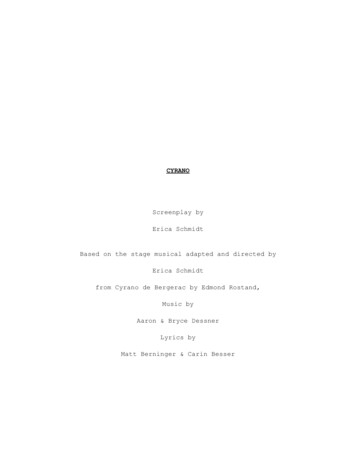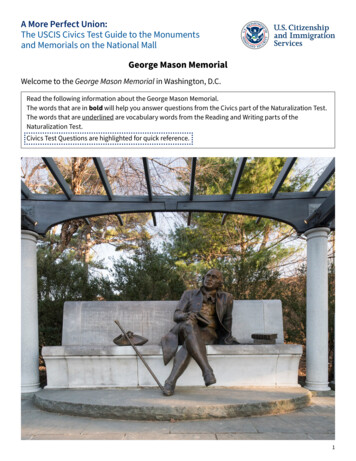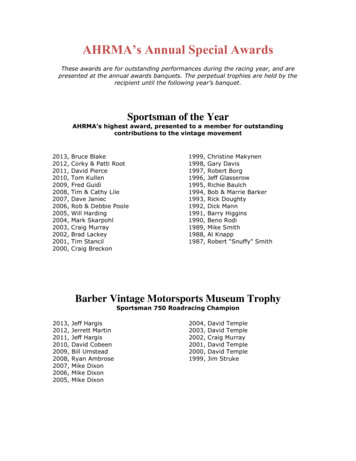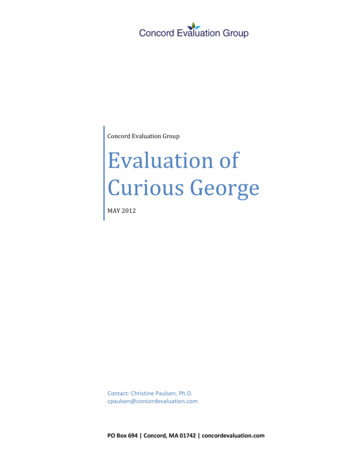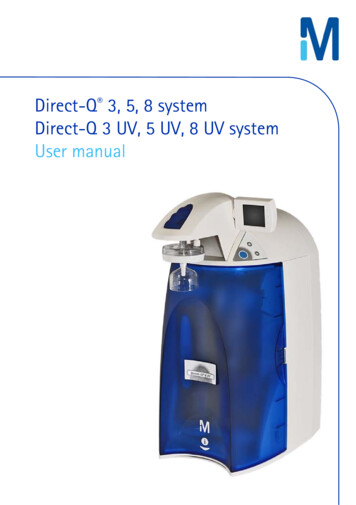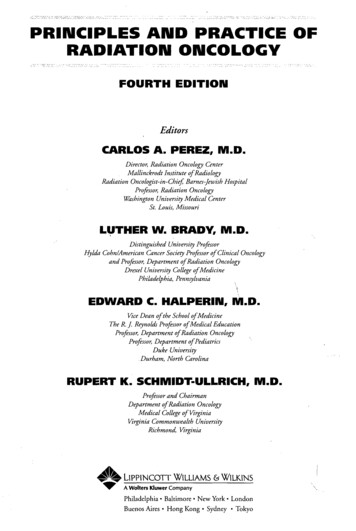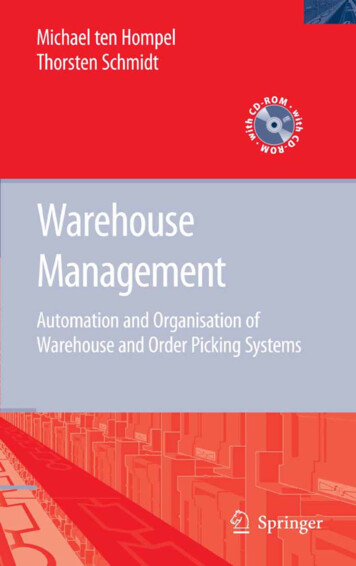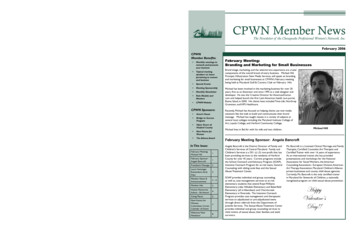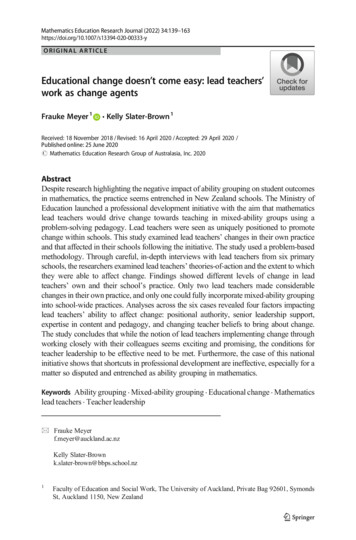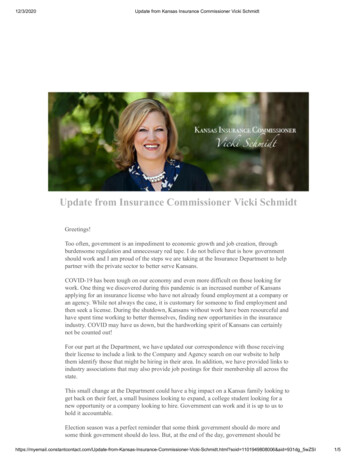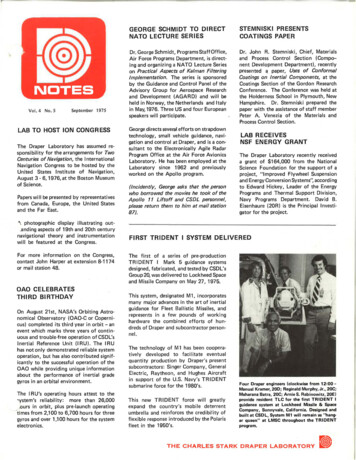
Transcription
Vol. 4 No. 5September 1975LAB TO HOST ION CONGRESSThe Draper Laboratory has assumed responsibility for the arrangements for TwoCenturies of Navigation, the InternationalNavigation Congress to be hosted by theUnited States Institute of Navigation,August 3 - 6, 1976, at the Boston Museumof Science.Papers wi II be presented by representativesfrom Canada, Europe, the United Statesand the Far East.'\ photographic display illustrating out.anding aspects of 19th and 20th centurynavigational theory and instrumentationwill be featured at the Congress.For more information on the Congress,contact John Harper at extension 8-1174or mail station 48.OAO CELEBRATESTHIRD BIRTHDAYOn August 21st, NASA's Orbiting Astronomical Observatory (OAO-C or Copernicus) completed its third year in orbit - anevent which marks three years of continuous and trouble-free operation of CSDL'sInertial Reference Unit (I RU). The I RUhas not only demonstrated reliable systemoperation, but has also contributed significantly to the successful operation of theOAO while providing unique informationabout the performance of inertial gradegyros in an orbital environment.The I RU's operating hours attest to the ystem's reliability:more than 26,000.ours in orbit, plus pre-launch operating,times from 2,100 to 6,700 hours for threegyros and over 1,100 hours for the systemelectronics.GEORGE SCHMIDT TO DIRECTNATO LECTURE SERIESSTEMNISKI PRESENTSCOATINGS PAPERDr. George Schmidt, Programs Staff Office,Air Force Programs Department, is directing and organizing a NATO Lecture Serieson Practical Aspects of Kalman FilteringImplementation. The series is sponsoredby the Guidance and Control Panel of theAdvisory Group for Aerospace Researchand Development (AGARD) and wilt beheld in Norway, the Netherlands and Italyin May, 1976. Three US and four Europeanspeakers will participate.Dr. John R. Stemniski, Chief, Materialsand Process Control Section (Component Development Department), recentlypresented a paper, Uses of ConformalCoatings on Inertial Components, at theCoatings Section of the Gordon ResearchConference. The Conference was held atthe Holderness School in Plymouth, NewHampshire. Dr. Stemniski prepared thepaper with the assistance of staff memberPeter A. Venezia of the Materials andProcess Control Section.Geo,rge directs several efforts on strapdowntechnology, small vehicle guidance, navigation and control at Draper, and is a consultant to the Electronically Agile RadarProgram Office at the Air Force AvionicsLaboratory. He has been employed at theLaboratory since 1962 and previouslyworked on the Apollo program.(lncidently, George asks that the personwho borrowed the movies he took of theApollo 11 Liftoff and CSDL personnel,please return them to him at mail station87).LAB RECEIVESNSF ENERGY GRANTThe Draper Laboratory recently receiveda grant of 164,000 from the NationalScience Foundation for the support of aproject, "Improved Flywheel Suspensionand Energy Conversion Systems", accordingto Edward Hickey, Leader of the EnergyPrograms and Thermal Support Division,Navy Programs Department. David B.Eisenhaure (20R) is the Principal Investigator for the project.FIRST TRIDENT I SYSTEM DELIVEREDThe first of a series of pre-productionTRIDENT I Mark 5 guidance systemsdesigned, fabricated, and tested by CSDL'sGroup20, was delivered to Lockheed Spaceand Missile Company on May 27, 1975.This system, designated M1, incorporatesmany major advances in the art of inertialguidance for Fleet Ballistic Missiles, andrepresents in a few pounds of workinghardware the combined efforts of hundreds of Draper and subcontractor personnel.The technology of M1 has been cooperatively developed to facilitate eventualquantity production by Draper's presentsubcontractors: Singer Company, GeneralElectric, Raytheon, and Hughes Aircraftin support of the U.S. Navy's TRIDENTsubmarine force for the 1980's.This new TRIDENT force will greatlyexpand the country's mobile deterrentumbrella and reinforces the credibility offiexible response introduced by the Polarisfleet in the 1950's.Four Draper engineers (clockwise from 12:00 Manual Kramer, 20D; Reginald Murphy, Jr., 20C;Maharana Batra, 20C; Arnie S. Rabinowitz, 20E)provide resident TLC for the first TRIDENT Iguidance system at Lockheed Missile & SpaceCompany, Sunnyvale, California. Designed andbuilt at CSDL, System M1 will remain as "hangar queen" at LMSC throughout the TRIDENTprogram. THE CHARLES STARK DRAPER LABORATORY
MIT CO-OPS ASSIGNEDTO CSDLLOUIS ANASTASITO TEACHSix MIT Course VI-A co-op students havebeen assigned to the Draper Laboratory,according to Education Department Head,Bill Manlove .Louis Anastasi, a General MaintenanceForeman with the Physical Plant & Facilities Planning Department, will be leavingthe Laboratory this month to teach Electrical and Career Education in the Industrial Arts Department of Stoneham HighSchool.Course VI-A, The Electrical EngineeringCourse with Industry and Government atMIT, enables students to combine industrialexperience with their academic work . MITco-ops are ablP to earn undergraduate elective credit for each term of work at theDraper Lab. Currently undergraduatesthese MIT students will continue in theprogram to at least the Master's level, withthesis work being done in the Laboratory.MIT co-ops are : Edward J. Gilbert, who isworking with Lance Drane (Digital Computation Department, 40B), solving problems related to high reliability software;Keith E. Serra; who is working with JuriValge (Air Force Programs Department,15B), in the pointing and tracking development for lasers; Gordon P. Sharp, whois working with Albert Hopkins (NASA/Army Programs Department, 1 OL), oncomputer hardware and software designin Fiat and NASA Langley equipment;Eric F. Strovink, who is working with JohnHursh (Air Force Programs Department,15B), on system programming on an Interdata 70 computer; Russell Nevins, who isworking with William Grigg (Navy ProgramsDepartment, 20E), developing a generalpurpose assembler on HP2100 and assisting in system software development; EricSherman, who is working with JamesDeckert (NASA/ Army Programs Department, 10C) , on engineering support forthe study of sensor and effector failuredetection techniques for the F-8 DigitalFly-By-Wire (DFBW) aircraft and programming support for the FORTRAN IBM/360F-8 simulator and Hybrid F-8 simulator.is considerably in excess of 300, some time isavailable to make plans to meet this expense.If there are complicat(ons of pregnancy, inclu, iing delivery by Caesarean, which cannotanticipated, the hospital bill is covered in t To include full payment of hospital bills fornormal maternity in our coverage at the presenttime would increase the cost of a family BlueCross- Blue Shield membership by an additional 2.80 per month, at a time when our regularBlue Cross - Blue Shield costs have risen byalmost 30% in one year.0. I've lost my MBTA Pass. What shouldI do?A. It is important to notify the Benefits Officeimmediately in the event that your MBTA Passis lost or stolen. You will be given a form whichyou may take, after a ten-day waiting period, toany of the following locations and receive areplacement Pass:Community Affairs Office - Back Bay Station745 Dartmouth Street - Boston, Mass. 027 76Mon. - Fri. 8: 30 - 4: 30Senior Citizen's Registration CenterGovernment Center MBTA Station 02203Mon. - Fri. 9:00- 3:30Treasurer-Controller's Office500 Arborway - Jamaica Plain, Mass. 02730Mon. - Fri. 8:30- 4:30Louis AnastasiLou, who has been part of the Laboratoryfor 20 years, was graduated from Wentworth Institute and has a Teaching Certificate from Fitchburg State Teachers' College. He has taught adult education coursesin Electric Wiring in Watertown and inNewton for the past four years and wasinvolved in the EdCo Program at Draper.Lou is presently enrolled in ContinuingEducation courses at Fitchburg and BostonState Colleges.FOR YOUR BENEFIT:As a regular feature of 0-NOTES, thiscolumn will share with all employees theanswers to questions most frequentlyasked of the Benefits Office. For moreinformation, please call extension 8-2656.Advisor to the Course VI-A students atDraper is Professor Alan S. Willsky, Assistant Professor of Electrical Engineering andComputer Science, who recently receivedthe Donald P. Eckman Award from theAmerican Automatic Control Council.Professor Willsky was honored for his outstanding contributions to modern controland estimation theory.0. Why does my Blue Cross - Blue Shieldcoverage only pay 300 toward the hospital bill for delivery of a baby?For more information on the Course VI-ACo-op program at Draper, contact BillManlove at extension 8-1590 or mail station 48.A. The primary purpose of Blue Cross - BlueShield is to protect you and your family againstthe impact of sudden, unexpected, often large,medical bills resulting from illness or injury.Although the average hospital stay for maternity-2-The MBTA will only replace one Pass ryear. If you lose your Pass more than onc.it is still important to notify the BenefitsOffice, so that your payroll deductionscan be stopped.CSDL Board Members and Officers gathered for a group photograph during a recent tour of the new Draper facility.
FLYNN TO SERVE WITHUNITED WAYDL SECURITY GUARDSPREVENT CAR THEFT obert Flynn, Chief of the ClassificationManagement Section, Office of Safety andSecurity Services, has been appointed, bythe Draper Laboratory, as a Loaned Executive to the United Way of MassachusettsBay.Three veteran members of the DraperLaboratory Security Force prevented thetheft of a car parked in D L6 Lot D on thecorner of Albany and Pacific Streets onAugust 18th.Lt. Joseph Loghran and Draper GuardRobert Lang, while on a routine motorpatrol, detected three persons engaged insuspicious activity around a '63 red Dodgeconvertible owned by George Flamburis,Physical Plant and Facilities Department.Loghran and Lang investigated the situation and detained the three teenagedsuspects. The two Draper men were assistedby Guard Richard Griffith until the arrivalof the Cambridge Police Department, whoGuards, continued page 5FROM THE DRAPER SAFETY OFFICERob FlynnRob's assignment is part of the Laboratory's continuing involvement with theUnited Way. Last year, the Draper Laboratory received the Award of Excellencerom the United Way for "attaining amajor increase in total employee contributions coupled with outstanding management and employee support."Rob will work with the United Way for aperiod of three months beginning in September. He will function as an extensionof the United Way staff during the crit icalcampaign period for 1975. Working directly with Key Persons and Volunteer Campaign Chairpersons, Rob will assist inassuring the success of company employeecampaigns.DR. DRAPER TO RECEIVEKELVIN GOLD MEDALDr. Charles Stark Draper, Founder andSenior Scientist of the Draper Laboratory,has been selected by the Award Committeeof the Institution of Civil Engineers toreceive the Kelvin Gold Medal for 1974.The medal is being presented to Dr.Draper;n London, on September 9th, in recog,1ition of his outstanding contributions tovehicle guidance, control and instrumentation through his pioneering developmentof inertial navigation systems.The Draper Laboratory Safety Office,through the Martin Extinguisher Company,is now making it possible for employeesto purchase fire extinguishers at a reducedprice. If you are interested in examininga display of these extinguishers, call extension 8-1618. In the meantime , the SafetyOffice offers this advice for dealing withfires in the home .Fires in the home are most often causedby faulty heating systems and fireplaces,"tired" portable heaters, faulty chimneys,misuse of electricity, etc. An average of1500 home fires occur daily. Don't letyour house burn down!Fire fighting is tricky. No one can tellyou whether to fight a fire in your houseor to evacuate the building immediately.However, if you know the basic facts abouttrying to put out a fire, you can make anintelligent on-the-spot decision.If the fire is small, and you have the properextinguisher, it can probably be put outsafely. At the same time, you should"sound the alarm" so that people in thehouse can evacuate the premises. Don'tfoolishly waste precious minutes battlinga fire wh ile leaving residents trapped in abuilding. Call the Fire Department immediately, no matter how small the fire.If in doubt about your ability to arrestthe fire, or if your efforts seem to beinadequate, by all means, leave. Smoke and- 3-fumes from burning material are highlytoxic and can affect you quickly. Whateveryou do, never underestimate a fire. Flamesdo not eat their way slowly from objectto object - they spread rapidly. Superheated air can rise rapidly up a stairwayand ignite materials upstairs setting a wholehouse ablaze in seconds.Some lucky people have managed to stampout fires with their feet, brooms, blankets,pans full of water - but hundreds of othershave died using these makeshift devices.The only dependable extinguishing agentother than water for rubbish fires is a goodfire extinguisher. The best home extinguisher is generally considered to be acompact dry chemical type. It containsabout 2% lbs . of sodium bicarbonate baseextinguishing agent and is listed by Underwriters' Laboratories for flammable liquidand electrical fires. This type of extinguisher will also "knock down" the flameson such combustibles as wood, fabrics,paper, etc.If you have a fire in your home and youare successful in putting it out, you shou Idstill call the Fi re Department.Remember: Water extinguisher for paper,wood, cloth, rubbish; dry chemical extinguisher for burning liquids, oils, cookingfats ; and co 2 (Carbon dioxide) for liveelectrical equipment.CSDL EDUCATION WITHINDUSTRY PROGRAMFour officers selected by the Air ForceSystems Command for participation in the"Air Force Institute of Technology Education With Industry Program" at the Laboratory met with Dr. Draper recently.Pictured from left to right are: CaptainMichael A. Spatola, Major Ben W. Bolton,Captain Larry W. Pennell, Dr. Charles S.Draper, and Lt. Colonel F. J. Liberatori.They will be stationed at Draper for oneyear of on-the-job training.
graduate days at Cooper Union School ofEngineering, he majored in MechanicalEngineering, with an informal minor inorganizing and managing handball and basketball tournaments. Flush with success,he entered Cornell University for graduatework in Engineering Mechanics. As a teaching Assistant there, Sam tried his ownteaching methods and was rated tops inhis department in a student poll of facultymembers. At the same time, the CornellFolk Dancers doubled in membership during his year as publicity chairman.PEOPLE:SANTO "SAM" BENICHASASam came to the Laboratory in 1965 towork with the Navy Mechanical DesignDiv.ision as a stress and vibration analyst.He is presently a member of the ElectronicPackaging Division, working with GeorgeIves and Ed Duggan.The folks at his jam sessions call him "SamRagtime". At MIT, the Athletic Department callshim "Sam Softball". In college, he was knownas "Sam Handball". More than an avid participator, Sam senichasa is an originator, an organizer,an improviser. Whether there's chaos, or a needfor something new, he's ready to jump in withhis classic trademark, "another public service bYSam".Sam's organizational abilities first surfacedwhile attending Brooklyn Technical HighSchool, where he started a rock'n'roll fanclub, the "Tech-Kats". During his under-IEEE STUDENTS TOURDRAPER LAB,While living in Somerville for the past tenyears, Sam has become unusually activeon the political scene and was an officerin several civic groups. When an importantcity-wide petition drive (requiring 6,500signatures in two weeks) excited his interest in 1969, Sam took over and devised asuccessful method for coordinating petitioners. It was the first successful petitiondrive in the city's recent history, and themethod is still used for political canvassing .As commissioner of the MIT CommunitySoftball League, Sam has made severalinnovative changes in the League's format.As a result of his campus-wide advertising,the League has grown from 12 to 38 teams.In addition, Sam pitches for the Ashdownteam in that League and is also the manager-player of the Divestors, winners of theDraper Noontime Softball League championship this year.During MIT's Independent Activities Period(IAP). Sam gave a minicourse on "Sam'sSimple Sensible System of Measurements",which is designed to eliminate the acceleration of gravity from all engineering calculations. With units such as a "Wham",a "Zap" and a "SuperSam per Square Subdrop", it might be difficult to take himseriously.Representatives from Northeastern University student chapter Institute of Electricaland Electronics Engineers (IEEE) visitedthe DL6 Hybrid Test F 1cility recently aspart of a tour of the Draper Laboratory.When Sam finds a good thing, he doesn'tkeep it to himself. He spreads the word.After taking a course in Silva Mind Control,which thoroughly impressed him, heinvited the instructor to give a lecture atMIT. As a result, 38 persons from MIT andDraper Lab took the course. Afterward,Sam formed the MIT "Psi Club" for graduates of the course.-4-Two years ago, Sam invited some musiciansto his home for a jam session, and theyhave continued ever since on a monthlybasis.Featured in the Boston Sunday Globe, thesessions have attracted musicians. of alllevels of competence from all over theBoston area. Playing everything fromtrumpets to kazoos, they perform Dixieland, ragtime, blues and traditional jazz.Recently, the group got together, calledthemselves "Sam's Jam Band", and playedat Bette's Rolls Royce, a local restaurant.Because Sam has recently moved, the jamsessions are now looking for a new permanent home. Any volunteers?In the meantime, if.anyone is looking fora jam, just contact Sam at Mail Station 80.CSDL WHEELCHAIR LIFTDEVELOPEDTesting the wheelchair lift at DL7 is Dick Warren .The pilot model for a simple do-it-yourselfkit that can be assembled into a wheelchairlift by anyone with a high school education is now undergoing its final testing anddesign evaluation on the back loading platform at DL7.This project began as a part of a design exercise for a class in Practical Engineeringfor the Physically Handicapped, which Rehabilitation Engineer Richard Warren hasbeen teaching for the past two years tohigh school students from the CottingSchool for Handicapped Children.The wheelchair lift is another in a serieof "Draperkits", or do-it-yourself aids forWheelchair Lift, continued page 5
GUARDS, Continued· adbeen immediately notified. The three spects were placed under arrest by theCambridge Police Officers and were chargedwith attempted car theft.PROFESSIONAL SUMMER 1975During the week of July 28th, a course,Sensors, Instrumentation and Control forCombat Systems, was presented by CSD Lpersonnel as part of the MIT/CSDL Professional Summer series of lectures. Thecourse was coordinated and introducedby Education Department Head WilliamManlove and included presentations byEmery St. George, Sonar; Don Fraser,Principles of Control Systems; CharlesHrbek, Self Contained Navigation Systems; Duncan Cox, Satellite Aids; GeorgeSchmidt, Integrated Navigation SystemDesign; Art Ciccolo, Computers for Instrumentation and Control; Pierre Doganand Margaret Hamilton. Software Development Principles; Brian Cuevas, Controland Design Methodology and System Integration; and Mike Sapuppo, Gyros andAccelerometers.On the job at DL6 are Lt. Joseph Loghran (C)and Draper Guards Richard Griffith and RobertLang.The installation of closed circuit televisionand increased guard, motor and foot patrolshave curbed automobile theft in the DL6parking areas.WHEELCHAIR LIFT, Continuedthe handicapped. Tommy Concannon'stypewriter, featured in the May/June 1973issue of D-NOTES, is another device whichRichard Warren hopes will revolutionizethe delivery of engineering technology forthe handicapped.The two basic premises in the conceptionof these devices is an attempt to keep engineering designs simple so that the handicapped can be taught to assemble and tomaintain their own aids. This would resultin a major reduction in the present highcost of aids due mainly to the cost of laborin assembly, and in a powerful technologybeing made available to a much widermarketplace.Several Lab members made valuable contributions to the program. Rocky Garofano,Component Development Department, didthe original engineering drawings and madea number of important design suggestionsIVhich were incorporated in the presentmodel. Additional assistance was providedby Bill Tortorella and members of the Physical Plant Office, who did the carpentrywork, and Jim Melendy, of the Businessand Legal Department.Additional presentations were given byFloyd Johnson and Sol Norman, Honeywell Radiation Control, Radiation Sensors;and Bob O'Donnell, Lincoln Laboratory,Shipborne Radar and Radio Aids for Navigation.Professional Summer is a program ofcourses organized and developed by theInstitute and the Draper Laboratory forOfficers and civilian personnel working insystems design and analysis and in specific technologies important to the U.S.services.Duncan Cox, Leader of the Special Projects Division, Air Force Programs Department, presentsa lecture on Satellite Navigation, as part of theLaboratory's involvement in "Professional Sum-mer".THREE FROM LAB TO TEACHAT LOWELLThree Draper Lab members will be teaching courses at the Lowell Institute School(LIS), starting in September. Established atMIT in 1903, LIS provides evening coursesin technically-oriented fields.The following courses will be taught byCSDL personnel: Mechanical Drafting 1,111and Dimensioning and Tolerancing forEngineering Drawings, Virginia McCauley;Technical Writing, Helen D. Nayar; Technical Public Speaking, Anne-Marie Seltzer.For additional information, please contactLIS, Room 5-118, or call 182-3-4895.SMOOTH SAILING FOR MIT SALTSJoanne Crane, Paul Halloran and NormLarkin, Design & Documentation Section,Component Development Department, ina joint effort with the MIT Nautical Association, have produced an instructionmanual, Sailing and the Tech Dingy.The manual was prepared as a guide tobasic sailing and is used as a supplementto courses given by the Nautical Association to perspective sailors.The fourteen pages of illustrations andinstructions for navigators which comprise the manual, cover Basic Sailing, TheWind, The Centerboard, Trimming theBoat, Helmsman's Position in the Boat,Crew's Position in the Boat, Tacking,Jibbing, the Basic Course, Rules of the-5-Road, and Precautions. A special section is devoted to Nautical Terms, Splicing, Fittings, Anchors, Whipping, andKnots.Paul did the cover for the manual, as wellas ancilliary artwork for the inside pages,while Joanne did the typing. NormanLarkin assisted in both the writing andediting, as well as artwork. The Drapertrio worked on the manual on a volunteerbasis and on their own time.Copies of the manual are availablethrough the Sailing Pavillion on Memorial Drive for 25q. For more information please contact Norm Larkinat 8-2692 or mail station 79.
CSDL GOLF LEAGUENEWSThe DL6 and Component DevelopmentDepartment (COD) Evening Golf Leaguesconcluded their regular 17-week scheduleon August 28th. Both leagues, each composed of ten two-person teams, plan postseason tournaments, outings and prizeawards this month.CSDL BRIDGE GAMEANYONE FOR BRIDGE ?This month's problem is something else.See-what you can do with it.If anyone is interested in a bit of competi:.tive bridge, please let us knl1w. We wou!like to form teams of four and have anoontime competition. It need not beevery noontime; perhaps two days a week.The MIT/DL Bridge Club is looking formore members.KING-SIZE PROBLEMEast-West vulnerableDealer NorthIf you are interested, please call ArthurBoyce at 8-1414 for more information .Our newest member at Draper is JamesShuman, DL5-103B.NORTHThere was no interleague play during theregular season. The course played by DL6was Putterham Meadows in Brookline,while Leo J. Martin Memorial Golf Coursein Weston was the regular site for COD. 42.K10876 AJ 59' 042SOUTHPeter Brooks is president; Ralph Pupa isvice president of the D L6 league. Their1st place team is Joe Tencati & Bob Cieslik.Leading scorer with low gross average isSteve Bonarrigo; low net average - JohnDiSorbo; low gross - Peter Brooks; lownet - Bob Burke. Other team members are:Bob Kennedy, Bob Leger, George Mitchell,Andy Lofgren, Cookie Samuelian, Al Pitts,Bill MacFarland, Tony Kondolean, BillCurtis, Dick Bazer, Joe McGee and TonyCasile. Subs are Bill Abely and Peter Engel.In the COD Golf League, Vern Assarian ispresident, with Bob Price, vice president.Leading scorer-low gross is John Stemniski.They have two teams tied for the lead:Vern Assarian & Eric Gelotte, and GeneFairweather & John Crepeau. Also thereis a three-way tie for the low handicap:Vern Assarian, Randy Archer, and HarryLerman. The high handicap leader is EricGelotte. Additional COD league membersare: Frank Knowles, Tom Telesmanick, JohnStemniski, John Palmieri, Joe Baxter, LeoHughes, Bob King, Russ Daniels, JoeWalsh,Bob Scheisser, Herb Singer, Arnie Smith.Subs are: Bill Eng, Ira Weymouth and PeteTavanis.September 4th, the COD League is havingtheir tournament and outing. Golf at thePembroke Country Club will include playoffs of the team and low handicap ties.Later in September the DL6 League willplay a final tournament at Brookmeadowin Canton. Peter Brooks will host the outing and awards.AQ103.AQJ95 4. A83,.SOUTHNORTHPassSALTZBERG SOLVES TWO-SUITER6 1Bill Saltzberg, Dll 1-206, did it this time.Congratulations, Bill. The solution to lastThe way you play you can afford to bid Ii ke that.month's problem is below.SOLUTIONOpening lead: Three of diamondsPlan the play. (Trumps are 2-1)The first correct answer shall receive adeck of Bicycle playing cards and Honorable Mention in D-NOTES. The next fourcorrect answers will receive an HonorableMention in D-NOTES.Send all answers to Ben Dares, DL5-165mail station 26. Ben will also answer requests for information on teams-of-fourcompetition.LAB MEMBERS ANO RESIDENTSINTERESTED IN PARTICIPATINGIN CSOL SPEECH PROGRAMSTHIS FALLARE REQUESTED TO CONTACTANNE-MARIE SELTZER ATEXT. 8-3514The following services are being offered:1. Speech ClassesD-NOTES is published for the personnel of theCharles Stark Draper Laboratory. Inc . Cambridge, Massachusetts. News and contributionsshould be addressed to D-NOTES and forwardedto Technical Communications, Room DL3-407,68 Albany Street, Cambridge, Massachusetts,02139. Telephone (617) 258-2601. Editor Marilynn P. Brass.If you do not play bridge now, but wouldlike to learn, MIT/DL will form a noviceclass, but would like to have a minimumof four persons for the class. If you areinterested, call Sam Smith at 8-3666 formore information .2. Individual Aid in OrganizingPresentations3. Speech Workshops- 6 -NORTH.J732 s2.Q AK8764J3EASTWEST K J9 3 J9 4 3K 9724 109 8.AQ1074 Q 10 54oaSOUTH.AK654 85 24A10654Win the diamond and ruff a diamond immediately!This play is made just in case the queen of spadesdrops singleton, in which case you wil I have enoughdummy entries to establish the diamonds, assuminga normal 4-3 division.Obviously, the hand cannot be made if trumps are3-1 (unless the queen is singleton), and the hand iscold if trumps are 2-2. If you fail to ruff a diamondat trick four and find the queen of spades singleton,you are going to have to rely upon a good break inclubs, which is less likely than a good break indiamonds.After you ruff the diamond, play the ace of spades.If the queen falls, draw trump ending in dummy,and play the king of diamonds. If everyone follows,ruff a diamond and claim your contract, concedinga club.If somehow diamonds turn out to be 5-2, you sti''make the hand if East has the king-queen of clulby leading a low club to the ten rather than ruffi !J'a second diamond. If East splits, win and concedea club. If he does not, he gets a club at the end,providing he had four clubs.
gyros in an orbital environment. The I RU's operating hours attest to the ystem's reliability: more than 26,000 .ours in orbit, plus pre-launch operating ,times from 2,100 to 6,700 hours for three gyros and over 1,100 hours for the system electronics. GEORGE SCHMIDT TO DIRECT NATO LECTURE SERIES Dr. George Schmidt, Programs Staff Office,
